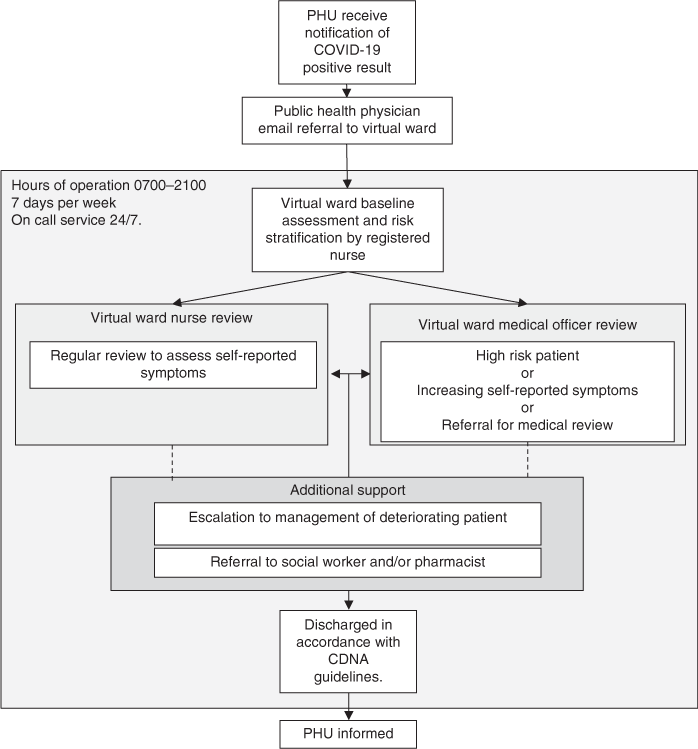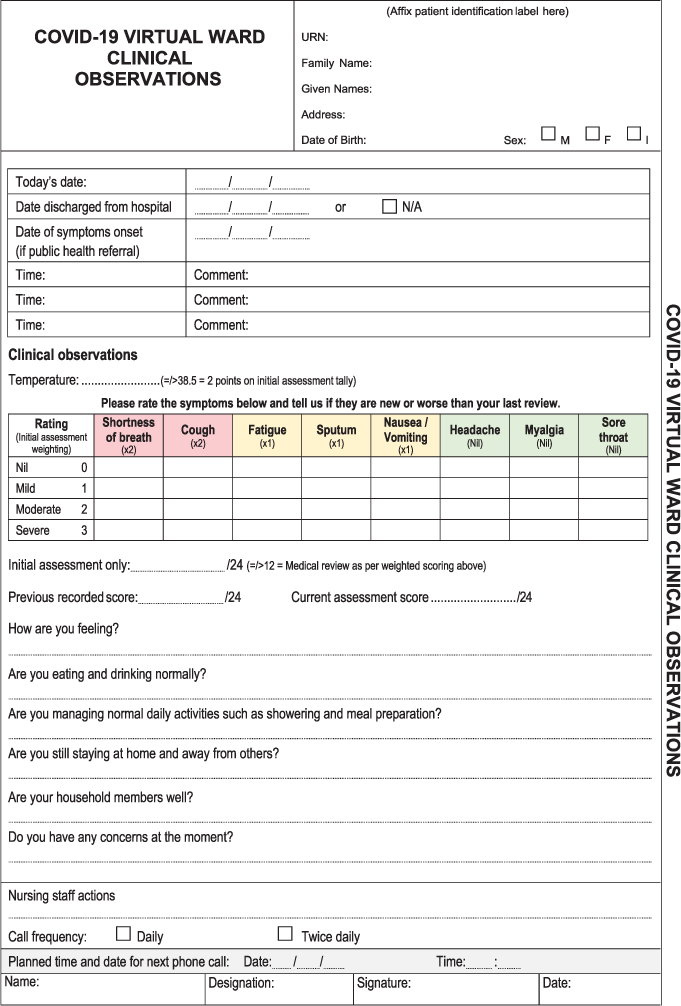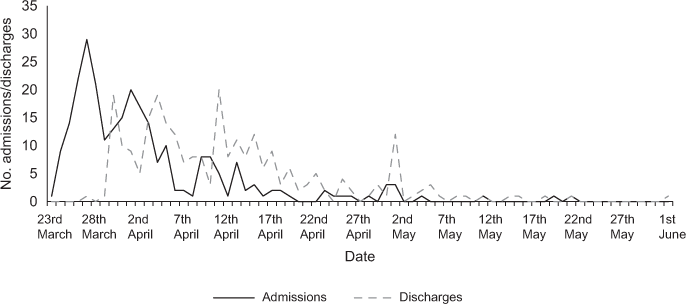Implementation of a virtual ward as a response to the COVID-19 pandemic
Katherine Schultz A E , Helen Vickery B , Katrina Campbell C D , Mary Wheeldon A , Leah Barrett-Beck B and Elizabeth Rushbrook BA Brighton Health Campus, 19th Avenue, Brighton, Qld, Australia. Email: Mary.Wheeldon@health.qld.gov.au
B Medical Services, Metro North Hospital and Health Service, Royal Brisbane and Women’s Hospital Campus, Bowen Bridget Road, Herston, Qld, Australia. Email: Helen.Vickery2@health.qld.gov.au; Leah.Barrett-Beck@health.qld.gov.au; Elizabeth.Rushbrook@health.qld.gov.au
C Healthcare Excellence and Innovation, Metro North Hospital and Health Service, Lobby 1 Citilink, 3 Campbell Street, Herston, Qld, Australia. Email: Katrina.Campbell@health.qld.gov.au
D Menzies Health Institute Queensland, G40 Griffith Health Centre, Gold Coast Campus, Griffith University, Qld, Australia.
E Corresponding author. Email: Katherine.Schultz@health.qld.gov.au
Australian Health Review 45(4) 433-441 https://doi.org/10.1071/AH20240
Submitted: 5 September 2020 Accepted: 8 December 2020 Published: 12 April 2021
Journal Compilation © AHHA 2021 Open Access CC BY
Abstract
Objective The aim of this study was to describe and evaluate the implementation of a virtual ward as a COVID-19 hospital avoidance response strategy and identify opportunities for improvement and future applicability.
Methods A mixed-method observational study was conducted of a centralised virtual ward, which operated in a large metropolitan Australian health service from 23 March to 1 June 2020.
Results In total, 238 unique patients were admitted to the virtual ward, accounting for 264 individual admission episodes and 2451 virtual bed days. Twenty (7.6%) episodes resulted in transfer to hospital and 136 patients provided responses to feedback surveys and reported their experience as very good (61.7%, n = 87) or good (34.8%, n = 49). Implementation success was high, with the model widely accepted and adopted across the health service. The service delivery model was considered to be low-cost in comparison to inpatient hospital-based care.
Conclusions Overall, as a rapidly developed and implemented low-tech model of care, the virtual ward was found to provide an effective, accessible and low-cost solution to managing low-acuity COVID-19-positive patients in the community. This model should be considered in future pandemics as a hospital-avoidance response, with the ability to minimise patient-to-healthcare worker transmission, reduce personal protective equipment use and enhance patient adherence with isolation requirements. Targeted remote telemonitoring should be considered as a future modification to improve patient care.
What is known about this topic? Virtual wards aim to reduce hospital demand by providing hospital-level care in community settings such as the patients’ home. The COVID-19 pandemic has seen a rapid increase in the utilisation of virtual wards as an acute healthcare response that facilitates contactless care of infectious patients. Despite this rapid adoption, there is limited literature on the effectiveness of virtual ward models of care in a pandemic context.
What does this paper add? This study provides a detailed description of the implementation of a virtual ward in a large metropolitan health service. It evaluates the effectiveness of the virtual ward as a COVID-19 response strategy and identifies opportunities for improvement and future applicability. This study contributes to the growing body of literature on the COVID-19 healthcare response and virtual wards.
What are the implications for practitioners? This study details the implementation of a virtual ward and highlights potential facilitators and barriers to successful implementation and sustained applicability. Findings provide a comparative benchmark for other health services implementing virtual wards as a pandemic response strategy.
Keywords: COVID-19, models of care, pandemic, evaluation, response strategy, virtual care, virtual ward, RE-AIM, CFIR, implementation.
Introduction
Virtual care is defined as a clinical interaction that occurs remotely, using various information technologies and communication modalities, between the healthcare provider and the patient.1,2 Virtual wards use virtual care modalities to replicate the systems, staffing and daily routines of a hospital ward without the presence of a physical ward.3 The premise for a virtual ward is based on a model of hospital substitution whereby alternative models of care can reduce demand on hospitals, yet retain appropriate management of patients in their own home.4
Implementation of virtual hospital care has demonstrated improved patient access, outcomes and health service efficiencies, including reduced healthcare costs.5
The COVID-19 pandemic presents significant challenges to health and social care systems internationally. The rate and degree of transmission is resulting in significant global morbidity and mortality and threatening to cripple healthcare systems due to the unprecedented demand on hospital care.6 This rapid increase in demand for inpatient hospital care has led to the need for health services to explore innovative models of care to support COVID-19-positive inpatients. This response includes the use of virtual wards.7,8
In response to increased demand for utilisation of virtual health care, there is a need and urgency for health services to undertake appropriate robust evaluation of the implementation of virtual care in a pandemic context to inform future planning and optimisation of a virtual ward model.
Aim
This study aims to describe and evaluate the implementation of a virtual ward as a COVID-19 response strategy and identify opportunities for improvement and future applicability. This study will contribute to a growing body of literature on COVID-19 healthcare responses and virtual wards.
Methods
Setting
This study was conducted in a virtual ward established during the COVID-19 pandemic in a large metropolitan health service in Australia, which serves a population of approximately 1 million residents.
The implementation of a virtual ward was explored in response to an initial health department requirement for all positive COVID-19 cases to be managed as inpatients and the anticipated large volume of low-acuity, highly infectious patients. The objective was to enable an alternate model of care to inpatient hospital-based care that provided safe and effective management of COVID-19 positive patients while maintaining isolation requirements.
The initial model of care included two virtual wards operated separately by the two tertiary facilities within the health service. Due to increasing demand and to enable streamlining of procedures and processes, a single, centralised health service virtual ward was established. The centralised ward operated from 23 March 2020 until 1 June 2020 and was delivered 100% virtually through telephone-based consultations from staff based at a hospital facility.
Participants
All adult community-dwelling residents or visitors within the health service catchment with a pathology confirmed diagnosis of COVID-19 were referred to the virtual ward by the Public Health Unit (PHU). Initially, children were admitted to the virtual ward before a decision to transfer all care to the tertiary Children’s Hospital.
Patients who presented to an emergency department (ED) or from an inpatient ward with a COVID-19 diagnosis, who were deemed clinically safe to be managed at home, were also referred upon discharge to the virtual ward.
Virtual ward intervention
The virtual ward aimed to provide a service delivery model that monitored and supported symptomatically well COVID-19-positive adult patients from across the health service, in their own home, and to provide advice and escalation for those who become unwell (Fig. 1). This virtual ward did not include returned travellers in hotel quarantine. The virtual ward staffing profile varied by demand and included Administrative Officers, Allied Health staff (Pharmacy and Social Work), Nursing staff and Medical Officers.
At initial clinical assessment, the interval for telephone monitoring was established through a risk assessment tool (Fig. 2) with individual’s receiving daily or twice daily calls. This could be modified based on subsequent consultations and risk reassessment. Patients with scores of ≥12 were referred to a Medical Officer for review, as per management of the deteriorating patient pathway (Fig. 3).
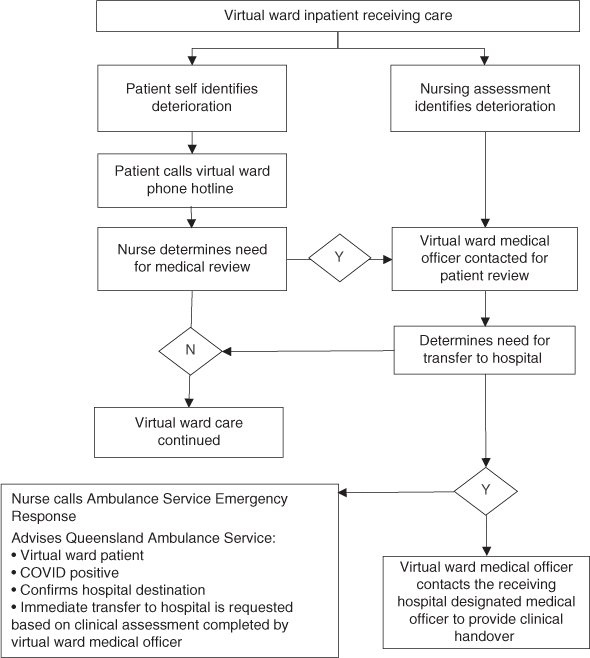
|
Multidisciplinary referrals could be initiated to a pharmacist for complex medication reviews and social work to provide psychosocial support, and access to food and finance management support as required.
Patients were discharged in accordance with the Communicable Diseases Network Australia COVID-19 guidelines ‘release from isolation criteria’.9
Patients who were not contactable by telephone after two consecutive attempts were escalated to the PHU for follow up and management.
Study design
A mixed-method observational design was utilised for the evaluation of the centralised virtual ward.
The evaluation used the RE-AIM framework10 to identify key evaluation dimensions (Reach, Effectiveness, Adoption, Implementation and Maintenance) and questions (Table 1).
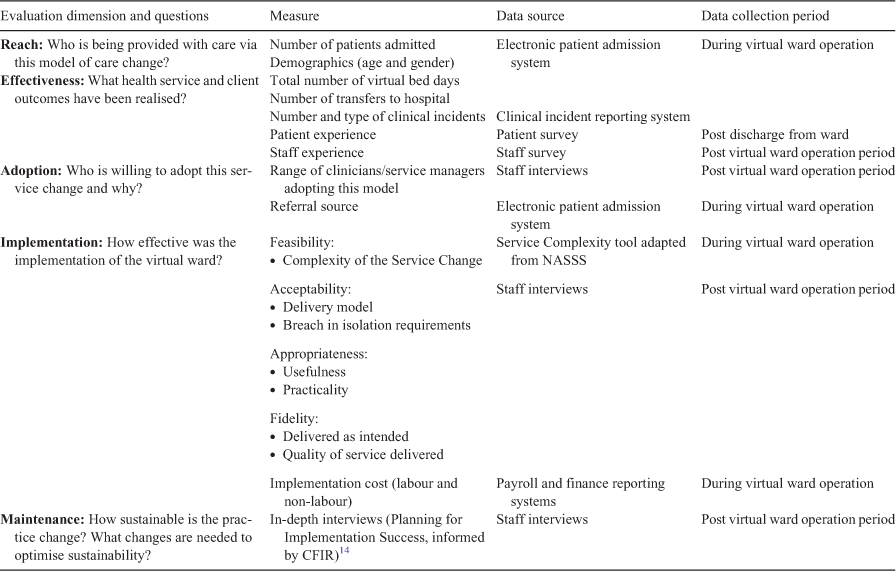
|
Reach was determined by quantifying the number and demographics (gender and age) of patients admitted to the virtual ward. Effectiveness was determined by measuring the total number of virtual bed days as a measure of inpatient bed days saved, number of patients requiring hospital admission, number and type of clinical incidents, and staff and patient experience.
The taxonomy proposed by Proctor et al.11was used to define implementation outcomes, which included feasibility, acceptability, appropriateness, fidelity and cost. Feasibility was determined by assessing the complexity of the service model using a self-assessment tool (NASSS-CAT)12 adapted from the NASSS (Non-adoption, non-Abandonment, Scale-up, Sustainability and Spread) framework.13
The Consolidated Framework for Implementation Research (CFIR)14 was used to guide semi-structured interviews with staff on the model acceptability, appropriateness, fidelity, adoption and maintenance. Implementation cost was determined by quantifying the labour and non-labour costs associated with the management and operation of the ward. Labour costs included direct operating costs for Administration, Allied Health (Social Work, Pharmacy and Team Leader), Medical and Nursing staff. Indirect labour costs included staffing costs for an Operations Director and a Security Information Manager. Non-labour costs included hiring of room space, computer levies, and information technology equipment. Accommodation costs for the patient were not included as all patients were cared for within their own home. To determine cost effectiveness, the average cost of a virtual ward bed day and separation was compared with the average cost of an inpatient hospital bed day and separation.
Data collection
Quantitative and qualitative data for key measures identified were collected from administrative data sources (electronic patient management systems, payroll and finance reporting systems), surveys and semi-structured interviews (Table 1).
A Service Complexity Assessment was administered with the virtual ward Operations Director to determine initiative feasibility by identifying areas of complexity and challenges to sustainability.
Patient and staff experience surveys were administered by internal staff as part of a planned service review in June 2020 via an email link to an online survey (Supplementary Table S1 and S2). All patients had a registered email address upon admission and received the survey by email between 1- and 8-weeks’ post discharge. Patients were also sent a reminder text message notifying them of the survey and requesting their participation. In addition, in-depth semi-structured interviews were conducted by two independent evaluators (KS and HV) on selected staff who had clinical delivery and operational management responsibilities (Supplementary Table S3).
Data analysis
Descriptive statistics were used to present quantitative data including number of patients admitted, patient demographics (age and gender), number of virtual ward bed days, number of transfers to hospital, number and type of clinical incidents, and data reported in patient and staff surveys. Model of care costs were analysed to provide an average cost per bed day and an average cost per separation.
Thematic content analysis was conducted on qualitative data received through patient and staff surveys. Staff interviews were recorded with consent and transcribed verbatim for analysis and thematic coding by two independent evaluators (KS and HV).
Ethics
This study was granted ethical clearance (waiver) from the Royal Brisbane and Women’s Hospital HREC (LNR/2020/QRBW/64414) on the basis that this is a quality assurance project.
Results
Who was care provided to?
During the evaluation period, 238 unique patients were admitted to the virtual ward, accounting for 264 individual admission episodes. All eligible patients were admitted to the virtual ward. Patients had an average age of 45.9 years, ranging from 18.8–84.3 years (s.d. 18.5), excluding two children initially admitted then transferred to the care of the Children’s Hospital. Gender distribution was nearly equal between patients identifying as female (52.5%) and male (47.5%). The majority of patients (n = 190, 79.8%) admitted to the virtual ward reported recent travel, predominately overseas travel (n = 183).
What outcomes were realised?
During the period of service operation, the virtual ward provided a total of 2451 virtual bed days. The majority of patients (89.5%, n = 213) had a single admission episode, 10.1% of patients (n = 24) had two admission episodes and one patient had three admission episodes (0.4%).
The number of admissions per day was varied, ranging from 0 to 29 with a median of 1 (Fig. 4). The average length of stay per episode was 9.3 days (s.d. 7.1 days) with a median of 7.0 days. The number of discharges per day was variable, ranging from 0 to 20 with a median of 1.
There were 29 reported ED presentations; 25 presentations were due to deterioration of health associated with the COVID-19 virus, two were for chest pain, one was for a fall and one for removal of sutures. And 20 of the 29 ED presentations resulted in a hospital inpatient admission.
Overall, 244 (92.4%) episodes resulted in patients completing their isolation in their home/usual care residence and being discharged from the virtual ward. Twenty (7.6%) episodes resulted in discharge (transfer) to hospital. Median length of stay for patients who were admitted to hospital was 1 day, with three patients having extended length of stays exceeding 15 days due to complications. And 15 patients were readmitted to the virtual ward following discharge from hospital and completed their episode at home and were discharged.
In terms of patient experience, 140 patients and one carer completed the administered survey, accounting for a 60% response rate; the remaining 40% did not provide survey responses. Respondents had a broad age range (18–84 years) with an equal distribution of male and female. Most respondents (97.2%, n = 137) spoke English as their primary language. Overall, patients reported their virtual experience as very good (61.7%, n = 87), good (34.8%, n = 49), poor (2.1%, n = 3) or very poor (1.4%, n = 2). Patient experience feedback highlighted some levels of dissatisfaction with the lack of physical face-to-face assessment and follow up (see Supplementary Table S4 for patient interview themes).
Two independent evaluators (KS and HV) analysed data and categorised responses from 141 patient and 17 staff surveys into key themes. Staff experience surveys were completed and returned by 17 of the 22 virtual ward staff employed, including 10 nurses, one Allied Health staff member and six Administration Officers. And 94.1% (n = 16) of staff reported their time as a virtual ward staff member as positive and felt supported in their role.
How effective was the implementation?
All hospitals across the health service adopted the centralised virtual ward model. Virtual ward staff interviewed reported that the model of care was delivered as intended and remained entirely virtual throughout the service operation with nil direct contact between patients and staff. Staff reported high acceptability of the model, and by patients, with only three potential patient isolation breaches identified and referred to the PHU for follow up and management.
There is a legal requirement for these patients to be in isolation so by having the virtual ward set up we were actually able to assist in compliance in isolation for the duration of the time that they needed to be there. (Staff #6)
The Service Complexity assessment identified eight areas of complexity (out of a possible 35). These mostly related to technical and operational issues, which were able to be addressed by the service.
Qualitative responses from staff surveys and interviews identified key themes relating to implementation successes and barriers (Supplementary Table S5).
Staff involved in implementation identified that there was rapid design followed by swift implementation. The processes to design and implement the model broadly followed quality improvement cycles; utilising key staff with significant experience in this process enhanced successful implementation.
The early phase of implementation was really just do it, reflect, learn and change because time was so critical, we stood the ward up in 5 hours. (Staff #6)
Disaster management command and control was identified as the key mechanism for achieving rapid design and implementation. The staff interviewed deemed this acceptable during the emergency pandemic response.
Everything was brainstormed and implemented over a short period of time. It just meant there was not the same level of consultation. If you were planning this at a different time, detailed consultation would have been required, instead it was ad-hoc phone calls and regular Incident Management Team teleconferences. (Staff #1)
A key success factor that supported rapid implementation was the low-tech (telephone-based) model of care, which kept essential service delivery requirements to a minimum.
The introduction of new technology requires a robust process around it, you can’t do it unless you apply a governance process. You run a significant risk of creating adverse outcomes by ‘just popping an oxygen saturation probe in the mail and sending it’. (Staff #7)
Additional key themes associated with successful implementation included existing strong working relationships, engaged executive, experienced clinical leadership, open communication and trust.
Barriers to change included the speed of implementation and the large volume of rapidly changing information for a novel disease, with an unknown disease progression. Staff reported these were overcome by strong teamwork, a culture of trust and open communication.
Opportunities for implementation improvements included the timeliness of the information technology platform development, which would have to include enabled electronic medical records, and broader stakeholder consultation.
An opportunity for service delivery improvement included dual notification (to the PHU and the virtual ward of a positive result) to reduce the time to initial clinical assessment. A further opportunity for model improvement was the utilisation of visual telecommunication devices and the need to provide selective patient monitoring.
If there was a very large outbreak home monitoring may be required, the small numbers may have given a false sense of security. If there were large numbers simple monitoring would need to be significantly considered. (Staff #1)
The total costs for non-labour and labour expenses for the virtual ward operating period was A$554 654.17, with labour costs contributing to the greatest proportion of expenditure (A$517 319.21) (Table 2; Table 3).

|

|
Costs fluctuated per fortnight in response to the volume of patients changing over time and subsequent staffing required to operate the ward (Table 3 includes full-time equivalent (FTE) range). The average cost per patient per bed day was A$226.30 and the average cost per separation was A$2100.96.
The cost per separation for the virtual ward was significantly lower than the average cost per acute hospital separation (average length of stay 4.5 days), in Australia (A$4885) and Queensland (A$4523), as determined by the Independent Hospital Pricing Authority.15
Discussion
As a rapidly developed and implemented low-tech model of care, the virtual ward provided an effective, highly accessible and cost-effective response to managing low-acuity COVID-19-positive patients in the community. Hospital capacity was preserved, and a large cohort of patients was able to be monitored at home, with only 7.6% requiring subsequent hospital admission. Staff and patients reported high levels of satisfaction overall.
Implementation was highly effective due to a team with experience in quality improvement, agile implementation, strong executive support, experienced clinical leadership, trust and open communication.
This evaluation provides information to support future pandemic responses through virtual models of care. The virtual ward model is considered advantageous during a pandemic due to minimisation of both exposure and subsequent transmission between patients and healthcare providers, reduced need for the use of personal protective equipment, and systems and processes that facilitate the maintenance of compliance with isolation requirements.16 Furthermore, it has potential to be used as a model for vulnerable workers due to the nature of the contactless virtual care.
Of note, this virtual ward provided care for a specific cohort of patients (i.e. individuals returning from overseas), in an environment and time period where there was minimal community transmission. We attribute the success of rapid implementation and cost effectiveness, in part, to the low-tech service delivery model. However, staff and patients both acknowledged the need for enhanced visual telecommunications and an element of selective patient monitoring if a large-scale outbreak were to occur with a different case mix of patients and to allow step down of higher-acuity patients to the virtual ward. In a recent comparable virtual ward study, remote-patient monitoring technologies including pulse oximeters, thermometers and videoconferencing equipment, were successfully utilised to provide care to a similar cohort of COVID-19-positive patients at home.7 Consideration needs to be given to the use of targeted remote monitoring to support screening, triage, diagnosis and monitoring of at-risk patients with infectious diseases such as COVID-19.17
Conclusions
Virtual wards can be an effective strategy to reduce hospital demand and preserve capacity during a rapidly evolving pandemic crisis. This study detailed the implementation of a virtual ward in a large metropolitan health service as a COVID-19 hospital demand management strategy. In our experience, the success of virtual wards in a pandemic context relied on strong executive engagement, agile leadership and a willingness from key stakeholders to rapidly adopt and accept new models of service delivery.
This study adds to a growing body of literature on COVID-19 response strategies and virtual wards. Findings provide a benchmark for other health services and provide opportunity for further comparative analysis, including comparative cost effectiveness.
Competing interests
The authors declare that they have no competing interests.
Declaration of funding
This research did not receive any specific funding.
Acknowledgements
The authors acknowledge the numerous dedicated clinical and administrative staff involved in this initiative.
References
[1] McGrail KM, Ahuja MA, Leaver CA. Virtual visits and patient-centered care: results of a patient survey and observational study. J Med Internet Res 2017; 19 e177| Virtual visits and patient-centered care: results of a patient survey and observational study.Crossref | GoogleScholarGoogle Scholar | 28550006PubMed |
[2] Shaw J, Jamieson T, Agarwal P, Griffin B, Wong I, Bhatia RS. Virtual care policy recommendations for patient-centred primary care: findings of a consensus policy dialogue using a nominal group technique. J Telemed Telecare 2018; 24 608–15.
| Virtual care policy recommendations for patient-centred primary care: findings of a consensus policy dialogue using a nominal group technique.Crossref | GoogleScholarGoogle Scholar | 28945161PubMed |
[3] Lewis G. Case study: virtual wards at Croydon Primary Care Trust. 2006. Available at: http://www.kingsfund.org.uk/sites/files/kf/field/field_document/PARR-croydon-pct-case-study.pdf [verified 1 June 2020].
[4] Lewis G, Bardsley M, Vaithianathan R, Steventon A, Georghiou T, Billings J, Do Dixon J. ‘Virtual wards’ reduce rates of unplanned hospital admissions, and at what cost? A research protocol using propensity matched controls. Int J Integr Care 2011; 11 e079
| ‘Virtual wards’ reduce rates of unplanned hospital admissions, and at what cost? A research protocol using propensity matched controls.Crossref | GoogleScholarGoogle Scholar | 21949489PubMed |
[5] Moore G, Du Toit A, Jameson B, Liu A, Harris M. Rapid evidence scan: the effectiveness of virtual hospital models of care. 2020. Available at: https://www.saxinstitute.org.au/wp-content/uploads/20.04_Rapid-Evidence-Scan_The-effectiveness-of-virtual-hospitals.pdf [verified 8 January 2021].
[6] World Health Organization. Coronavirus disease (COVID-19): situation reports June–August 2020. Report nos.: 162–194. 2020. Available at: https://www.who.int/emergencies/diseases/novel-coronavirus-2019/situation-reports [verified 8 January 2021].
[7] Hutchings O, Dearing C, Jagers D, Shaw M, Raffan F, Jones A, Taggart R, Sinclair T, Anderson T, Ritchie AG. Virtual health care for community management of patients with COVID-19. medRxiv 2020;
| Virtual health care for community management of patients with COVID-19.Crossref | GoogleScholarGoogle Scholar |
[8] Thornton J. The ‘virtual wards’ supporting patients with COVID-19 in the community. BMJ 2020; 369 m2119
| The ‘virtual wards’ supporting patients with COVID-19 in the community.Crossref | GoogleScholarGoogle Scholar | 32499317PubMed |
[9] Australian Government Department of Health, Communicable Diseases Network Australia (CDNA). Coronavirus disease 2019 (COVID-19): CDNA national guidelines for public health units. Version 2.4. 2020. Available at: https://www1.health.gov.au/internet/main/publishing.nsf/Content/cdna-song-novel-coronavirus.htm [verified 30 March 2020].
[10] Glasgow RE, Vogt TM, Boles SM. Evaluating the public health impact of health promotion interventions: the RE-AIM framework. Am J Public Health 1999; 89 1322–7.
| Evaluating the public health impact of health promotion interventions: the RE-AIM framework.Crossref | GoogleScholarGoogle Scholar | 10474547PubMed |
[11] Proctor E, Silmere H, Raghavan R, Hovmand P, Aarons G, Bunger A, Griffey R, Hensley M. Outcomes for implementation research: conceptual distinctions, measurement challenges, and research agenda. Adm Policy Ment Health 2011; 38 65–76.
| Outcomes for implementation research: conceptual distinctions, measurement challenges, and research agenda.Crossref | GoogleScholarGoogle Scholar | 20957426PubMed |
[12] Greenhalgh T, Maylor H, Shaw S, Wherton J, Papoutsi C, Betton V, Nelissen N, Gremyr A, Rushforth A, Koshkouei M, Taylor J. The NASSS-CAT tools for understanding, guiding, monitoring, and researching technology implementation projects in health and social care: protocol for an evaluation study in real-world settings. JMIR Res Protoc 2020; 9 e16861
| The NASSS-CAT tools for understanding, guiding, monitoring, and researching technology implementation projects in health and social care: protocol for an evaluation study in real-world settings.Crossref | GoogleScholarGoogle Scholar | 32401224PubMed |
[13] Greenhalgh T, Wherton J, Papoutsi C, Lynch J, Hughes A’Court C, Hinder S, Fahy N, Procter R, Shaw S. Beyond adoption: a new framework for theorizing and evaluating nonadoption, abandonment, and challenges to the scale-up, spread, and sustainability of health and care technologies. J Med Internet Res 2017; 19 e367
| Beyond adoption: a new framework for theorizing and evaluating nonadoption, abandonment, and challenges to the scale-up, spread, and sustainability of health and care technologies.Crossref | GoogleScholarGoogle Scholar | 29092808PubMed |
[14] Damschroder LJ, Aron DC, Keith RE, Kirsh SR, Alexander JA, Lowery JC. Fostering implementation of health services research findings into practice: a consolidated framework for advancing implementation science. Implement Sci 2009; 4 50
| Fostering implementation of health services research findings into practice: a consolidated framework for advancing implementation science.Crossref | GoogleScholarGoogle Scholar | 19664226PubMed |
[15] Independent Hospital Pricing Authority. National hospital cost data collection report: public sector, round 22 (financial year 2017–18). 2020. Available at: https://www.ihpa.gov.au/sites/default/files/round_22_nhcdc_report_public_sector_round_22_2017-18_-_pdf_version.pdf [verified 8 January 2021].
[16] Queensland Government, Queensland Health. Self-isolation for diagnosed cases of COVID-19 direction (No. 3). 2020. Available at: https://www.health.qld.gov.au/system-governance/legislation/cho-public-health-directions-under-expanded-public-health-act-powers/self-isolation-for-diagnosed-cases-of-covid-19-direction [verified 1 March 2020].
[17] Alwashmi MF. The use of digital health in the detection and management of COVID-19. Int J Environ Res Public Health 2020; 17 2906
| The use of digital health in the detection and management of COVID-19.Crossref | GoogleScholarGoogle Scholar |


